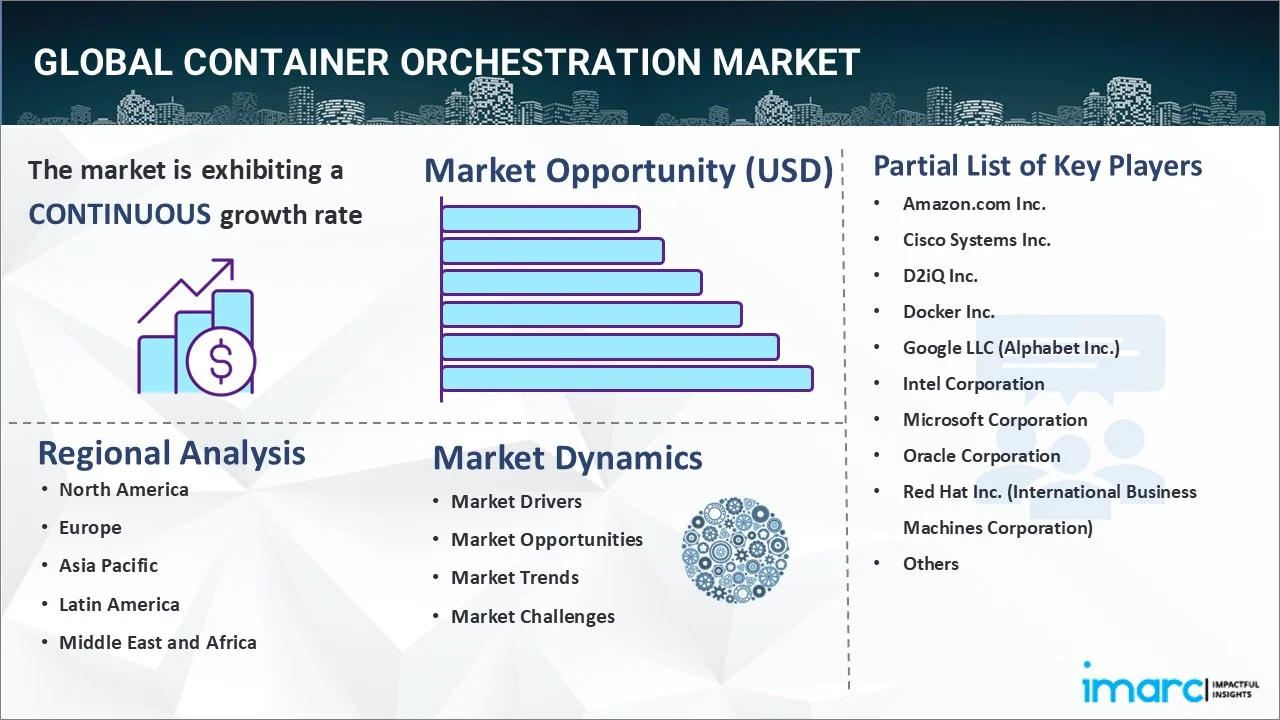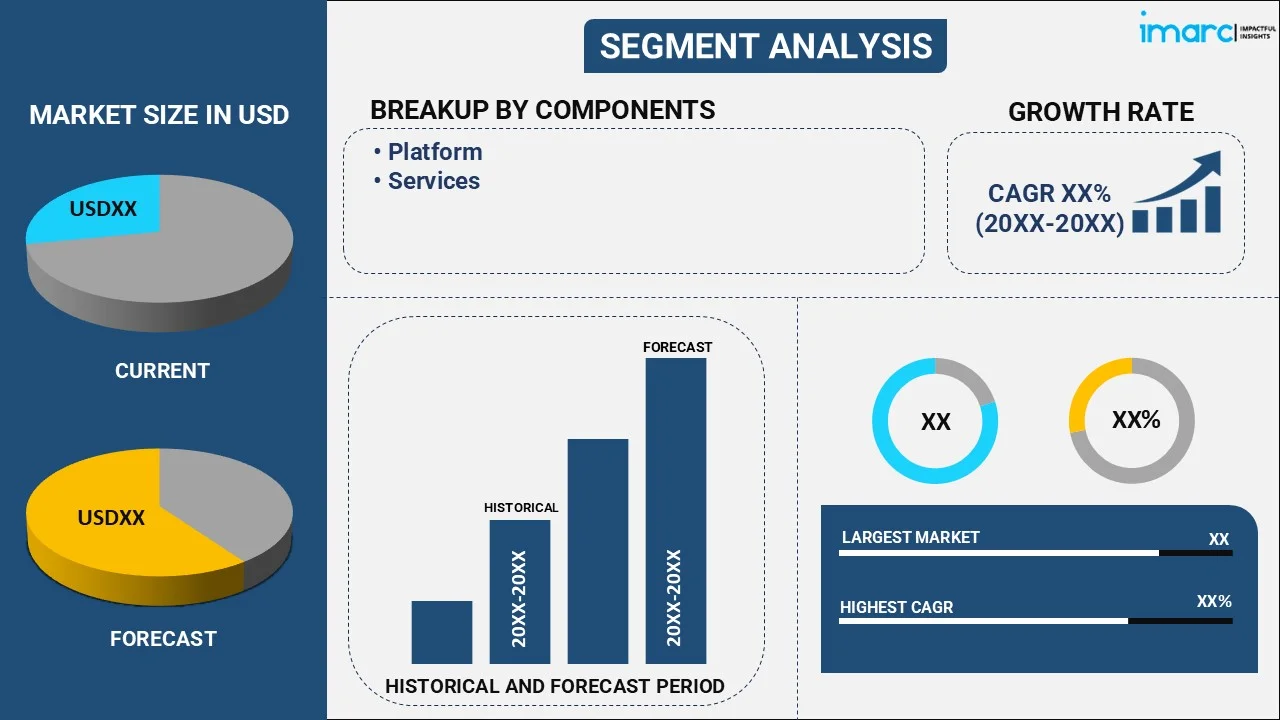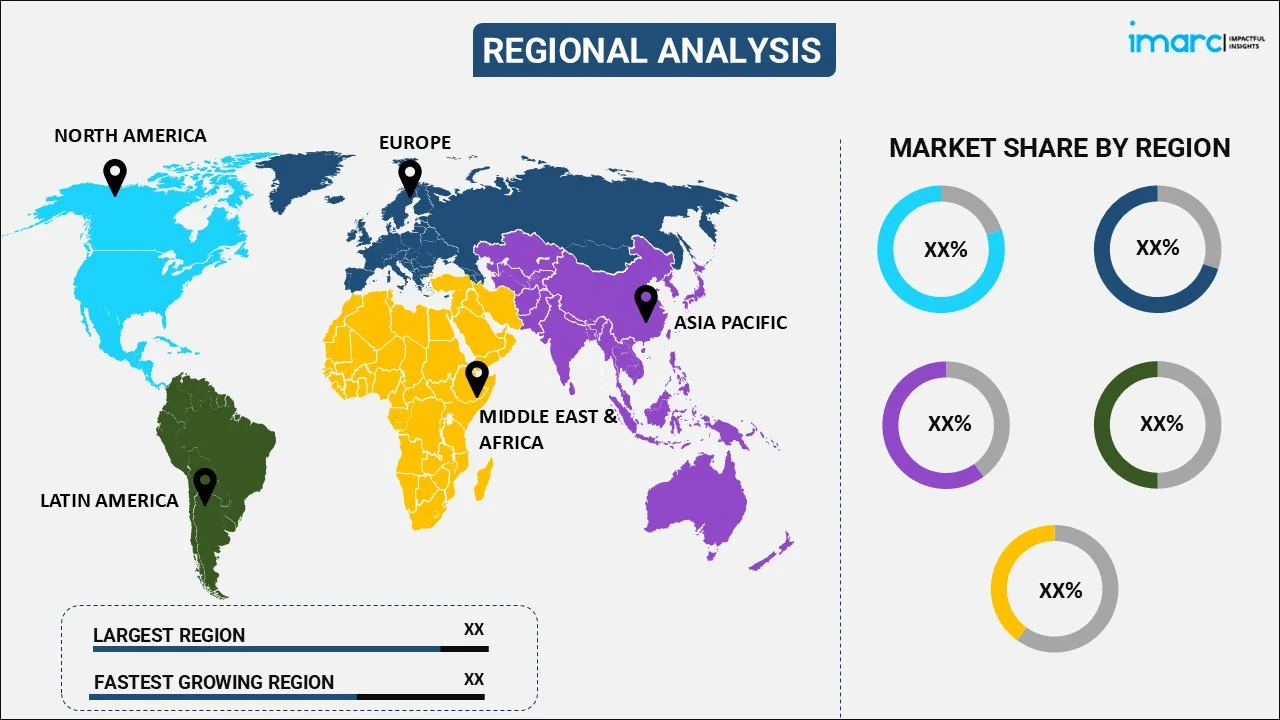
Container Orchestration Market Report by Component (Platform, Services), Organization Size (Large Enterprises, Small and Medium-sized Enterprises), Industry Vertical (BFSI, Government, IT and Telecom, Retail, Healthcare, and Others), and Region 2025-2033
Container Orchestration Market Size, Share
The global container orchestration market size reached USD 845.1 Million in 2024. Looking forward, IMARC Group expects the market to reach USD 4,007.8 Million by 2033, exhibiting a growth rate (CAGR) of 17.37% during 2025-2033. The increasing demand for automation across a range of industries, the integration of connected devices into the Internet of Things (IoT) framework and the adoption of micro-service architectures to manage workloads are some of the major factors propelling the market.
|
Report Attribute
|
Key Statistics
|
|---|---|
|
Base Year
|
2024 |
|
Forecast Years
|
2025-2033
|
|
Historical Years
|
2019-2024
|
| Market Size in 2024 | USD 845.1 Million |
| Market Forecast in 2033 | USD 4,007.8 Million |
| Market Growth Rate 2025-2033 | 17.37% |
Container orchestration is the process of managing and automating the deployment, scaling, and operation of containerized applications. Containers, which encapsulate an application and its dependencies, have revolutionized software development by enhancing portability and consistency across various environments. However, orchestrating these containers at scale is a complex task. Container orchestration platforms, such as Kubernetes and Docker Swarm, provide tools that simplify this challenge. It enables seamless deployment of containers across a cluster of machines, abstracting away the underlying infrastructure details. Automatic scaling ensures that applications can adapt to varying levels of load, optimizing resource utilization.

The global market is driven by the increasing demand for automation across a range of industries including telecommunication, information technology (IT), banking, financial services and insurance (BFSI), healthcare, retail, and manufacturing. Furthermore, the adoption of micro-service architectures to manage workloads and the utilization of open-source container platforms are contributing significantly to this growth trend. Container orchestration plays a pivotal role in efficiently packaging, deploying, and executing application workloads without the need for physical movement of hardware or operating systems. The market is further propelled by ongoing technological advancements, particularly the integration of connected devices into the Internet of Things (IoT) framework and the deployment of cloud computing solutions. These advancements are poised to further stimulate market growth. Enterprises are leveraging these technologies in conjunction with edge devices and distributed containers and networks within server environments. This integration enhances device communication, optimizes operational expenditures, and bolsters network reliability by preventing failures.
Container Orchestration Market Trends/Drivers:
Scalability and Resource Optimization
In today's fast-paced digital landscape, applications must seamlessly scale to accommodate varying workloads, from periods of high demand to lulls in activity. Container orchestration platforms, such as Kubernetes offer dynamic scaling features that allow applications to automatically adjust their resources based on real-time demand. This elasticity not only ensures optimal performance during peak traffic but also prevents over provisioning, which can lead to wastage of valuable resources and increased operational costs. With Kubernetes’s horizontal pod autoscaling, for instance, the number of replicas of a particular container can be automatically scaled up or down in response to metrics, including CPU utilization or memory consumption. Similarly, vertical scaling enables the adjustment of resource allocation within a single container instance. This fine-grained control maximizes efficiency, as resources are allocated precisely where they are needed.
Application Portability and Consistency
Traditional deployment models often encounter challenges when transitioning applications between development, testing, and production stages due to variations in underlying infrastructure. Containers alleviate this issue by encapsulating both the application and its dependencies, ensuring that it runs consistently across different environments, from developer laptops to cloud servers. Container orchestration platforms take this portability to the next level. Kubernetes provides a uniform way to define, deploy, and manage applications using declarative configuration files. Furthermore, orchestration tools facilitate the creation of immutable infrastructure, where application components remain consistent and unchanged over time. This consistency not only simplifies maintenance and troubleshooting but also bolsters security by reducing the attack surface.
High Availability and Fault Tolerance
Organizations are increasingly reliant on continuous service availability to cater to global audiences and critical business processes. Container orchestration platforms play a pivotal role in ensuring high availability and fault tolerance for applications, thus driving their adoption in the market. Kubernetes incorporates robust mechanisms to automatically handle the failure of containers or even entire nodes within a cluster. It supports self-healing capabilities, where unhealthy containers are restarted or replaced, and nodes are automatically rescheduled. This dynamic resilience not only reduces manual intervention but also enhances system reliability. Furthermore, orchestration tools enable the distribution of incoming traffic among healthy container instances through load balancing, effectively mitigating bottlenecks and ensuring even resource utilization. Rolling updates and canary deployments enable applications to evolve without service interruption, while maintaining a fallback mechanism to previous versions if issues arise.
Container Orchestration Industry Segmentation:
IMARC Group provides an analysis of the key trends in each segment of the global container orchestration market report, along with forecasts at the global, regional and country levels from 2025-2033. Our report has categorized the market based on component, organization size and industry vertical.
Breakup by Component:

- Platform
- Services
Platform dominates the market
The report has provided a detailed breakup and analysis of the market based on the component. This includes platform and services. According to the report, platform represented the largest segment.
Container orchestration platforms, including Kubernetes and Docker Swarm have emerged as cornerstones of modern software development and operations. These platforms offer a rich set of tools and services, ranging from container deployment and automated scaling to load balancing and service discovery. They provide a centralized hub for managing the entire lifecycle of containers, abstracting away the complexities of infrastructure management. Moreover, with the rapid proliferation of microservices architectures and the shift towards cloud-native development, businesses are increasingly recognizing the need for efficient container orchestration to maintain agility and competitiveness. These platforms not only streamline the process of deploying containerized applications across diverse environments but also enhance resource utilization, bolster reliability, and support continuous integration and continuous delivery (CI/CD) pipelines. Moreover, the platform component encompasses features that address various facets of modern software development, such as security, monitoring, and integration with other cloud services.
Breakup by Organization Size:
- Large Enterprises
- Small and Medium-sized Enterprises
Large enterprises dominate the market
The report has provided a detailed breakup and analysis of the market based on the organization size. This includes large enterprises and small and medium-sized enterprises. According to the report, large enterprises represented the largest segment.
Large enterprises typically manage complex and multifaceted IT infrastructures that require sophisticated solutions to effectively handle the deployment and management of applications. Furthermore, large enterprises often operate with a wide range of applications and services, spanning various departments, business units, and geographies. Container orchestration platforms offer a standardized approach to managing these diverse workloads, ensuring consistency across the organization, and reducing the complexities associated with managing different application stacks. The financial capabilities of large enterprises enable them to invest in the infrastructure required to support container orchestration at scale. This includes not only the hardware but also the expertise needed to implement and manage these platforms effectively. Additionally, large enterprises often deal with high levels of customer demand and are under pressure to deliver new features and updates swiftly. Container orchestration facilitates continuous integration and continuous delivery (CI/CD) practices, enabling faster release cycles and quicker responses to market demands.
Breakup by Industry Vertical:
- BFSI
- Government
- IT and Telecom
- Retail
- Healthcare
- Others
IT and telecom dominate the market
The report has provided a detailed breakup and analysis of the market based on the industry vertical. This includes BFSI, government, IT and telecom, retail, healthcare, and others. According to the report, IT and telecom represented the largest segment.
Container orchestration platforms, such as Kubernetes and Docker Swarm, have gained significant traction in the IT and telecom sector due to their ability to address the challenges of deploying, scaling, and managing applications across diverse environments. As these industries embrace microservices architectures and cloud-native practices, container orchestration provides the necessary tools to build, deploy, and scale these modular services while maintaining reliability and flexibility. In a sector characterized by ever-changing market dynamics and competition, container orchestration offers distinct advantages. It allows for rapid experimentation and deployment of new features, promoting agility in responding to customer demands. Moreover, the scalability and automation features of orchestration platforms align well with the resource-intensive nature of IT and telecom applications, ensuring optimal performance during peak usage periods while preventing over-provisioning. Additionally, the IT and telecom industry vertical often deals with a diverse set of applications, ranging from customer-facing web services to internal communication tools.
Breakup by Region:

- North America
- United States
- Canada
- Asia-Pacific
- China
- Japan
- India
- South Korea
- Australia
- Indonesia
- Others
- Europe
- Germany
- France
- United Kingdom
- Italy
- Spain
- Russia
- Others
- Latin America
- Brazil
- Mexico
- Others
- Middle East and Africa
North America exhibits a clear dominance, accounting for the largest container orchestration market share
The market research report has also provided a comprehensive analysis of all the major regional markets, which include North America (the United States and Canada); Asia Pacific (China, Japan, India, South Korea, Australia, Indonesia, and others); Europe (Germany, France, the United Kingdom, Italy, Spain, Russia, and others); Latin America (Brazil, Mexico, and others); and the Middle East and Africa. According to the report, North America accounted for the largest market share.
North America's emphasis on innovation and digital transformation has led to the early integration of container orchestration platforms, including Kubernetes into various industries. Businesses here recognize the need for agility and scalability to remain competitive in a rapidly evolving market, and container orchestration aligns perfectly with these requirements. The adoption of DevOps practices, which emphasize collaboration and automation between development and operations teams, is also prevalent in North America, further augmenting the implementation of container orchestration. Government initiatives to foster technological growth, coupled with a mature venture capital ecosystem, encourage investments in cutting-edge technologies, such as container orchestration. In lie with this, the presence of numerous tech hubs and innovation clusters in various cities contributes to the region's dominance in driving the development and adoption of container orchestration technologies.
Competitive Landscape:
Several leading companies are continually developing and enhancing their container orchestration platforms. They release updates, new features, and improved user interfaces to simplify the process of deploying and managing containers across clusters. Container orchestration providers are working to integrate their platforms with major cloud service providers like Amazon Web Services (AWS), Microsoft Azure, and Google Cloud Platform (GCP). This integration allows users to seamlessly deploy and manage containers within their chosen cloud environment. Many container orchestration solutions are integrating with Continuous Integration/Continuous Deployment (CI/CD) tools. This integration automates the process of building, testing, and deploying containerized applications, streamlining development pipelines. Numerous companies are partnering with other technology vendors, consulting firms, and managed service providers to create a comprehensive ecosystem that supports end-to-end container deployment, management, and optimization.
The report has provided a comprehensive analysis of the competitive landscape in the market. Detailed profiles of all major companies have also been provided. Some of the key players in the market include:
- Amazon.com Inc.
- Cisco Systems Inc.
- D2iQ Inc.
- Docker Inc.
- Google LLC (Alphabet Inc.)
- Intel Corporation
- Microsoft Corporation
- Oracle Corporation
- Red Hat Inc. (International Business Machines Corporation)
- SUSE S.A.
Recent Developments:
- In June 2023, Amazon.com Inc. launched tasks faster alongside tasks with prolonged shutdown. This enables customers to scale their workloads faster and improve infrastructure utilization.
- In October 2022, Oracle Corporation Expands App Development Portfolio with New Serverless Container and Messaging Services and Capabilities to Simplify Enterprise Adoption of Cloud Native Technologies.
- In May 2021, Red Hat Inc. (International Business Machines Corporation) and IBM Research launched the Konveyor Project. An open source project aimed at helping modernize and migrate applications for open hybrid cloud by building tools, identifying patterns, and providing advice on how to bring cloud-native transformation across IT.
Container Orchestration Market Report Scope:
| Report Features | Details |
|---|---|
| Base Year of the Analysis | 2024 |
| Historical Period | 2019-2024 |
| Forecast Period | 2025-2033 |
| Units | Million USD |
| Scope of the Report | Exploration of Historical Trends and Market Outlook, Industry Catalysts and Challenges, Segment-Wise Historical and Predictive Market Assessment:
|
| Components Covered | Platform, Services |
| Organization Sizes Covered | Large Enterprises, Small and Medium-sized Enterprises |
| Industry Verticals Covered | BFSI, Government, IT And Telecom, Retail, Healthcare, Others |
| Regions Covered | Asia Pacific, Europe, North America, Latin America, Middle East and Africa |
| Countries Covered | United States, Canada, Germany, France, United Kingdom, Italy, Spain, Russia, China, Japan, India, South Korea, Australia, Indonesia, Brazil, Mexico |
| Companies Covered | Amazon.com Inc., Cisco Systems Inc., D2iQ Inc., Docker Inc., Google LLC (Alphabet Inc.), Intel Corporation, Microsoft Corporation, Oracle Corporation, Red Hat Inc. (International Business Machines Corporation), SUSE S.A., etc. |
| Customization Scope | 10% Free Customization |
| Post-Sale Analyst Support | 10-12 Weeks |
| Delivery Format | PDF and Excel through Email (We can also provide the editable version of the report in PPT/Word format on special request) |
Key Benefits for Stakeholders:
- IMARC’s industry report offers a comprehensive quantitative analysis of various market segments, historical and current market trends, market forecasts, and dynamics of the container orchestration market from 2019-2033.
- The research report provides the latest information on the market drivers, challenges, and opportunities in the global container orchestration market.
- The study maps the leading, as well as the fastest-growing, regional markets. It further enables stakeholders to identify the key country-level markets within each region.
- Porter's five forces analysis assist stakeholders in assessing the impact of new entrants, competitive rivalry, supplier power, buyer power, and the threat of substitution. It helps stakeholders to analyze the level of competition within the container orchestration industry and its attractiveness.
- Competitive landscape allows stakeholders to understand their competitive environment and provides an insight into the current positions of key players in the market.
Key Questions Answered in This Report
The global container orchestration market was valued at USD 845.1 Million in 2024.
We expect the global container orchestration market to exhibit a CAGR of 17.37% during 2025-2033
The widespread adoption of Containers-as-a-Service (CaaS) platform to improve the communication between devices, optimize operational costs, and prevent network failures, is currently driving the global container orchestration market.
The sudden outbreak of the COVID-19 pandemic has led to the increasing application of container orchestration for remote and automated management of devices and programs used for running and managing the lifecycle of containerized workloads and services.
Based on the component, the global container orchestration market can be segmented into platform and services, where platform holds the majority of the total market share.
Based on the organization size, the global container orchestration market has been divided into large enterprises and small and medium-sized enterprises. Currently, large enterprises exhibit a clear dominance in the market.
Based on the industry vertical, the global container orchestration market can be categorized into BFSI, government, IT and telecom, retail, healthcare, and others. Among these, the IT and telecom sector accounts for the largest market share.
On a regional level, the market has been classified into North America, Asia Pacific, Europe, Latin America, and Middle East and Africa, where North America currently dominates the global market.
Some of the major players in the global container orchestration market include Amazon.com Inc., Cisco Systems Inc., D2iQ Inc., Docker Inc., Google LLC (Alphabet Inc.), Intel Corporation, Microsoft Corporation, Oracle Corporation, Red Hat Inc. (International Business Machines Corporation), and SUSE S.A.
Need more help?
- Speak to our experienced analysts for insights on the current market scenarios.
- Include additional segments and countries to customize the report as per your requirement.
- Gain an unparalleled competitive advantage in your domain by understanding how to utilize the report and positively impacting your operations and revenue.
- For further assistance, please connect with our analysts.
 Request Customization
Request Customization
 Speak to an Analyst
Speak to an Analyst
 Request Brochure
Request Brochure
 Inquire Before Buying
Inquire Before Buying




.webp)




.webp)












